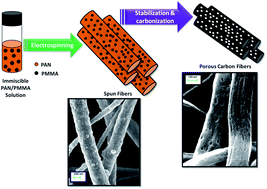Polymer blends yield carbon materials with superior performances for supercapacitor applications since blending can lead to controlled and fine pore architectures. In this study, a supercapacitor electrode material derived from an immiscible polymer blend comprising polyacrylonitrile (PAN) and polymethyl methacrylate (PMMA) was investigated. PAN was used as the carbonizing polymer while PMMA was used as the sacrificial polymer. The polymer blend solutions in DMF were electrospun to obtain freestanding nanofiber mats. The resulting mat was carbonized and activated by CO2 at 1000 °C to obtain porous carbon nanofibers (CNFs), as PAN converts to carbon and the sacrificial polymer decomposes creating pores. We demonstrated that the pore sizes can be tuned by varying the amount of PMMA loading in the blend compositions. PAN : PMMA (95 : 5), was found to be the optimum blend composition, affording the highest surface area of 2419 m2 g−1, higher degree of graphitization, higher carbon yield and lower charge transfer resistance among the blend compositions studied. Furthermore, the PAN : PMMA (95 : 5) CNFs showed the highest capacitance of 140 F g−1 and energy densities of 67 W h kg−1 at 3.5 V and 101 W h kg−1 at 4 V in an ionic electrolyte (EMITFSI) and also showed good cycling stability with 85% capacitance retention after 1000 cycles.

